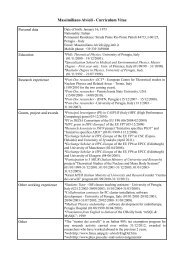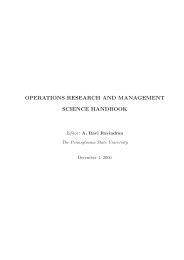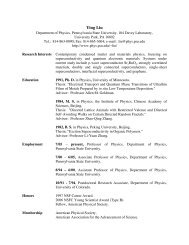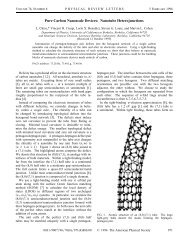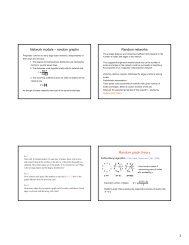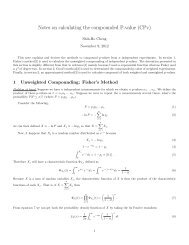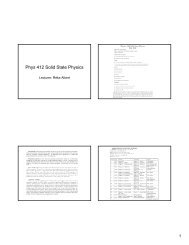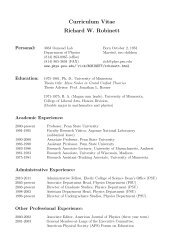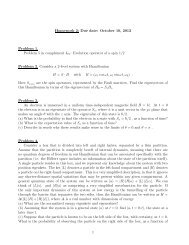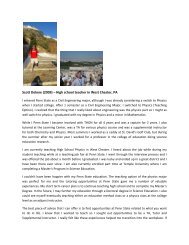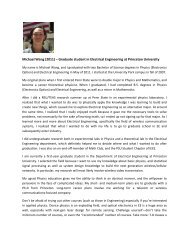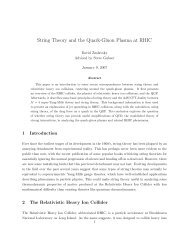Investigating Statistical Mechanics of Complex Supply Chain ...
Investigating Statistical Mechanics of Complex Supply Chain ...
Investigating Statistical Mechanics of Complex Supply Chain ...
You also want an ePaper? Increase the reach of your titles
YUMPU automatically turns print PDFs into web optimized ePapers that Google loves.
<strong>Investigating</strong> <strong>Statistical</strong> <strong>Mechanics</strong><br />
<strong>of</strong> <strong>Complex</strong> <strong>Supply</strong> <strong>Chain</strong><br />
Networks under Potential Risks<br />
PHYS597A Project, Spring 2007<br />
Presented by<br />
Satama Sirivunnabood<br />
Department <strong>of</strong> Industrial and Manufacturing Engineering
<strong>Supply</strong> <strong>Chain</strong> Network<br />
Onyx Team
Risks in <strong>Supply</strong> <strong>Chain</strong> Network<br />
• Delay <strong>of</strong> raw materials<br />
• Disruption risk: employee strike, politics, or hurricanes<br />
• Information System failures<br />
• Demand forecast risk<br />
• Intellectual property risk<br />
• Procurement risk: fluctuating prices <strong>of</strong> raw materials<br />
• Receivable risk: unable to get the money from<br />
customers<br />
• Inventory risk: uncertainty in supply<br />
• Capacity risk: machine breakdown or under utilization<br />
Onyx Team
Interesting Questions<br />
• What is the most appropriate evolving model for<br />
constructing a complex supply chain network?<br />
• How can we model the risks in a complex supply<br />
chain network?<br />
• What are the criteria should we use to determine<br />
the robustness <strong>of</strong> a supply chain network?<br />
• How can we improve the network robustness with<br />
the least redundancy?<br />
Onyx Team
Evolving model for A <strong>Supply</strong> <strong>Chain</strong> Network<br />
• Intuitively the behavior <strong>of</strong> the actual supply<br />
chain network is similar to the Barabási<br />
and<br />
Albert model<br />
Network growth<br />
Preferential attachment<br />
• However the probability <strong>of</strong> connection between<br />
a newly added node and the other existing node<br />
must be changed<br />
P(k i ) = k i / Σk i P(k i ) =(k i + 1) / (Σk(<br />
i + ΣN)<br />
Onyx Team
Evolving model for A <strong>Supply</strong> <strong>Chain</strong> Network<br />
• Also there are some additional features for the<br />
supply chain network<br />
Three types <strong>of</strong> node: supplier, manufacturer, and<br />
customer nodes<br />
Adding supplier node at every year, manufacturer<br />
node every 6 months, and customer node every<br />
month<br />
Attachment constraints : customer to manufacturer,<br />
manufacturer to supplier, and supplier to supplier<br />
Onyx Team
Evolving model for A <strong>Supply</strong> <strong>Chain</strong> Network<br />
1st echelon<br />
Supplier<br />
2nd echelon<br />
Manfacturer<br />
Manfacturer<br />
3rd echelon<br />
Customer Customer Customer<br />
Customer<br />
Customer<br />
Onyx Team
<strong>Statistical</strong> <strong>Mechanics</strong>:<br />
• Total number <strong>of</strong> nodes<br />
• Largest Connected Component (LCC)<br />
• Connectivity ratio = LCC / Total number <strong>of</strong> nodes<br />
• Average degree<br />
• Average path length / inverse geodesic length<br />
• Degree Distribution<br />
Onyx Team
Simulation <strong>of</strong> A <strong>Complex</strong> <strong>Supply</strong> <strong>Chain</strong> Network under Risk<br />
• Simulation <strong>of</strong> the complex supply chain network using<br />
the proposed model<br />
• The employee strike risk is selected and inserted into<br />
the model<br />
• Parameters <strong>of</strong> the employee strike risk:<br />
Probability <strong>of</strong> strike for each node is 0.05 during 90 days<br />
The duration <strong>of</strong> a strike is a triangular distribution with<br />
parameter (1,3,10) days<br />
The day where the strike begins is a uniform distribution<br />
between 1 and 90<br />
• The simulations were done for both model without risk<br />
and under risk for 10 years <strong>of</strong> simulation time<br />
Onyx Team
Simulation: The basic model<br />
Onyx Team
Simulation: The model under risk<br />
• Three types <strong>of</strong> model under risk<br />
1-attaching edge<br />
2-attaching edges (redundancy)<br />
3-attaching edges (high redundancy)<br />
Size<br />
LCC<br />
Connectivity Ratio<br />
Average Degree<br />
Average Inverse Geodesic Length<br />
Number <strong>of</strong> edges attached<br />
1 2 3<br />
143 144.4 143<br />
110.2 140.8 140.2<br />
0.771 0.975 0.980<br />
1.407 2.111 2.650<br />
0.177 0.320 0.352<br />
Onyx Team
Simulation: Largest Connected Component<br />
160<br />
LCC<br />
140<br />
120<br />
100<br />
80<br />
60<br />
40<br />
20<br />
0<br />
No risk<br />
1-edge<br />
2-edges<br />
3-edges<br />
1 6 11 16 21 26 31 36 41 46 51 56 61 66 71 76 81 86 91 96 101 106 111 116<br />
Time Steps<br />
Onyx Team
Conclusions & Future Works<br />
• The simulations were done to investigate the<br />
statistical mechanics and robustness <strong>of</strong> the<br />
supply chain network under the potential risk<br />
• The results indicate that adding redundancy<br />
more than 2 attaching edges does not improve<br />
the network robustness any further<br />
• Some future works:<br />
Agent-based systems for complex network modeling<br />
How can we characterization <strong>of</strong> the potential risks<br />
Design <strong>of</strong> topology for more robust networks<br />
Onyx Team



